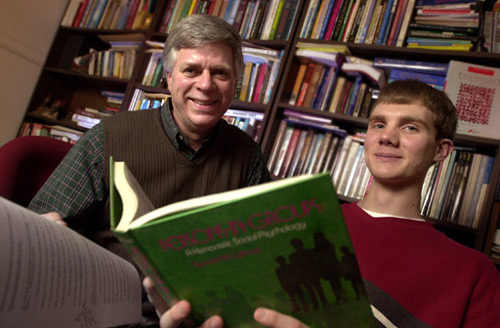Marquis Scholar John Hammond ’03 (Highland, Md.) is investigating the factors that influence people in large groups in an intensive independent research project this semester. A neuroscience major, he’s trying to determine the relationship between the functions of the brain and the phenomena of social contagion.
The anthrax scare that followed the September 11th terrorist attacks sparked Hammond’s interest in the topic. He explains that social contagion has the power to be positive – Americans joining together and celebrating their country – or negative – the fear that every envelope may contain anthrax, when statistically, very few actually did.
“While watching the news, I began to wonder what makes people so susceptible to the influence of those around them. People see their peers doing something and join in, usually without much forethought. This lack of forethought is the basis, in my opinion, of social contagion,” Hammond says. “I have always been interested in why people act the way they do, and social contagion is a great place to start.”
Hammond hopes to discover whether there is a certain brain state that occurs when people are in large gatherings that makes them more susceptible to following the crowd.
Alan Childs, associate professor of psychology, is advising the independent study. He says Hammond has a sound fundamental understanding of brain processes and is trying to see what others have discovered about how those processes might be involved in this interesting social behavior.
“He is curious to find out if anyone has made the link between brain functions and behaviors such as conformity, compliance, mass hysteria, mob behavior, riots, group panic, blind obedience, and other similar behavior,” Childs says.
“Working with John on this project is a joy,” he adds. “John challenges me in much the same way I hope I am challenging him through our discussions. I really look forward to our meetings each week. He has made excellent progress and I am sure he will write a significant paper on this topic by the end of the semester.”
Hammond feels that Lafayette provides an ideal environment for independent studies because the small classes allow for more personal interaction with professors. He also finds that faculty makes a concerted effort to get to know each student.
“The new psychology/neuroscience building scheduled to open next fall is also very appealing,” he adds. “I feel that Lafayette College is making every attempt to stay state-of-the-art and provide the best learning and research facilities possible.”
A graduate of Eleanor Roosevelt High School, Hammond is a resident adviser and member of the Crew Club and Psi Chi, the psychology honor society. Last year, he served as president of Crew Club and was a psychology tutor.

The anthrax scare following Sept. 11 inspired behavioral neuroscience major John Hammond ’03 to study the relationship between brain functions and social contagion with Alan Childs, associate professor of psychology.
